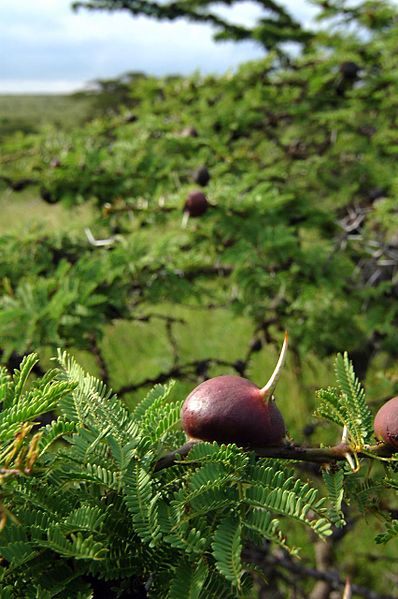 It can be hard to predict the outcomes of human interference in an ecosystem, even when it’s done with the best of intentions. This paper looks at the unforseen consequences of removing large herbivorous mammals from part of an African savannah, & demonstrates just how complex ecosystem interactions can be.
It can be hard to predict the outcomes of human interference in an ecosystem, even when it’s done with the best of intentions. This paper looks at the unforseen consequences of removing large herbivorous mammals from part of an African savannah, & demonstrates just how complex ecosystem interactions can be.
One fascinating mutualism on the African savanna is between the thorn-bearing Acacia trees and ants. One acacia, Acacia drepanolobium, produces 2 types of thorn – they may be slender, or swollen & hollow – & ants live in this second type. In addition, glands near the base of the tree’s leaves produce a sugary nectar that ants feed on. This production of nectar represents an energy cost, so what’s in it for the tree?
Palmer & his colleagues found 4 species of ant living in the acacias in their study area. One, Crematogaster mimosae, agressively defends its acacias agains herbivores by swarming & biting. This species of ant uses the hollow thorns as places to lay eggs, raise larvae, provide shelter for workers – & sometimes keep scale insects (for the honeydew that they produce). This was far & away the most common ant in the study area, found in 52% of acacia trees. A second species, C. sjostedti isn’t so aggressive about keeping herbivores away, & lives in borer-beetle tunnels rather than hollow thorns. It was found in around 16% of trees in the study area.
The other 2 ant species (each found in about 16% of trees) both defend their trees against herbivores to some degree, & they also work to prevent other ants from taking over their trees. One (C. nigriceps)prunes its trees so they don’t touch others, while the other, Tetraponera penzigi, destroys the acacia’s nectaries, so there’s nothing to attract C. mimosae to the trees.
In a study that’s been running since 1995, Palmer et al. (2008) excluded large (> 15kg) herbivores from a number of plots (exclosures), while others remained accessible to the big animals. In only 10 years, acacias in the exclosures reduced their production of both hollow thorns & nectar – but not on trees inhabited by C. nigriceps. The researchers hypothesise that this is because this ant prunes its host trees, which to the tree may represent browsing by mammals. So the tree keeps making nectar to attract protective ants. Interestingly, this response didn’t depend on the age of the trees – individual trees altered their production of nectaries & hollow thorns during the study period.
With no browsers – & so less nectar & shelter produced by the acacias – the ant community changed significantly. C. sjostedti became the most common species, while the number of C.mimosae colonies decreased by over 30% (& the size of their colonies also declined). C. mimosae ants spent much more time tending scale insects – and much less time responding to simulated herbivore browsing. As a result, the plants’ costs increased: more sap taken by scale insects, & potentially more browsing damage.
But it’s even more complex than that. You’d think the acacia trees would be better off without big mammals nibbling on them all the time. But with C. sjostedti more common in the exlosures, the trees were actually worse off. Trees with C. sjostedti colonies grow more slowly, & are more likely to die, than trees inhabited by the other ant species. This is probably due to damage by the boring beetles whose burrows provide homes for sjostedti, & which are encouraged by these ants (while the other ant species attack them). The researchers conclude: the large herbivores typical of African savannas have driven the evolution and maintenance of a widespread ant-Acacia mutualism and that their experimentally simulated extinction rapidly tips the scales away from mutualism and toward a suite of antagonisitc behaviours by the interacting species… Ongoing anthropogenic loss of large herbivores throughout Africa may therefore have strong and unanticipated consequences for the broader communities in which these herbivores occur.
T.M. Palmer, M.L.Stanton, T.P. Young, J.R. Goheen, R.M. Pringle & R. Karban (2008) Breakdown on an ant-plant mutualism follows the loss of large herbivores from an African savanna.
